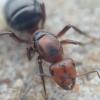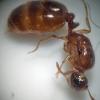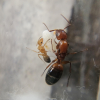- Formiculture.com
- Forums
- Gallery
- Members
- Member Map
- Chat

Aphaenogaster rudis Help
Started By
Goldsystem
, Nov 1 2022 2:10 PM
5 replies to this topic
#1
 Offline
-
Posted November 1 2022 - 2:10 PM
Offline
-
Posted November 1 2022 - 2:10 PM
I found what I’m assuming is a aphaenogaster rudis queen today however, I was planning on hibernating the rest of my ants before the end of the week. The aphaenogaster rudis queen has not laid any eggs yet and I’ve never hibernated a queen before they had their first workers, should I hibernate the queen with the rest of my ants? If not what steps should I take? Thank you. I’m located in Kansas if that changes anything.
#2
 Offline
-
Posted November 1 2022 - 3:06 PM
Offline
-
Posted November 1 2022 - 3:06 PM
It's a bit late in the year for Aphaenogaster, they tend to be more summer flyers. Could have been an ejection flight, a wandering dud, or maybe just a late actual flight. Queens that fly later in the year will usually wait until the spring to lay. I would hive her a week or so from when you caught her to give her a chance to lay eggs, and if she hasn't then just toss her in the fridge for 3 months with the rest of your ants.
#3
 Offline
-
Posted November 1 2022 - 3:44 PM
Offline
-
Posted November 1 2022 - 3:44 PM
It's a bit late in the year for Aphaenogaster, they tend to be more summer flyers. Could have been an ejection flight, a wandering dud, or maybe just a late actual flight. Queens that fly later in the year will usually wait until the spring to lay. I would hive her a week or so from when you caught her to give her a chance to lay eggs, and if she hasn't then just toss her in the fridge for 3 months with the rest of your ants.
Sounds good thanks for the advice.
#4
 Offline
-
Posted November 1 2022 - 8:06 PM
Offline
-
Posted November 1 2022 - 8:06 PM
I've found Camponotus sp. queens late in the year that where fertile. Nest rejects isn't always the only possibility as their brood could of also been killed off or their founding chamber could of been destroyed. I always give them a second year shot.
“If I am killed for simply living, let death be kinder than man.” -Althea Davis
#5
 Offline
-
Posted November 19 2022 - 11:58 PM
Offline
-
Posted November 19 2022 - 11:58 PM
I found what I’m assuming is a aphaenogaster rudis queen today however, I was planning on hibernating the rest of my ants before the end of the week. The aphaenogaster rudis queen has not laid any eggs yet and I’ve never hibernated a queen before they had their first workers, should I hibernate the queen with the rest of my ants? If not what steps should I take? Thank you. I’m located in Kansas if that changes anything.
Are you sure it was an aphaenogaster queen and not something like a myrmica queen? If you're not familiar with either species or the differences between them, one could easily misidentify them. They both have similar colors and both keep their gasters dipped down. Myrmica species tend to fly up until really late in the year, plus they're semi-claustral so they will forage for workers (making it hard to have a successful myrmica queen; there's been plenty of times I've found a myrmica queen and they've failed because she already had a claustral chamber somewhere with eggs, so she refused to lay eggs for me). Since they're semi claustral you could easily find them wandering about.
Aphaenogaster rudis fly in the late summer and early fall (at least in the midwest). I have two aph. rudis queens that I caught in early/mid september. Both of them just received their first nanitics 4 days ago (both have 3 workers each).
However if what you caught is indeed an aphaenogaster rudis queen, or even an aph. picea queen, she's probably an ejected alate. It's possible that she is still fertilized, as sometimes during ejections they can be treated by the alates as nuptial flights, but the chances are generally lower. I'd still keep her and just go ahead and hibernate her. They need 2-3 months of hibernation. Keep her between 40-50 degrees F and cool her SLOWLY (if you have the ability to do so, wrap her test tube with a ice pack or something to get her cool, let her adjust, and after about 10-15 minutes, put her in a fridge and keep her between 40-50 degrees F.) I do NOT recommend just throwing her in the fridge and letting her get cold quickly. I've done this before with aphaenogaster species and every queen died. I have not had a problem by doing it slowly and slowly cooling her to the proper temperature.
#6
 Offline
-
Posted November 20 2022 - 11:46 AM
Offline
-
Posted November 20 2022 - 11:46 AM
I found what I’m assuming is a aphaenogaster rudis queen today however, I was planning on hibernating the rest of my ants before the end of the week. The aphaenogaster rudis queen has not laid any eggs yet and I’ve never hibernated a queen before they had their first workers, should I hibernate the queen with the rest of my ants? If not what steps should I take? Thank you. I’m located in Kansas if that changes anything.
Are you sure it was an aphaenogaster queen and not something like a myrmica queen? If you're not familiar with either species or the differences between them, one could easily misidentify them. They both have similar colors and both keep their gasters dipped down. Myrmica species tend to fly up until really late in the year, plus they're semi-claustral so they will forage for workers (making it hard to have a successful myrmica queen; there's been plenty of times I've found a myrmica queen and they've failed because she already had a claustral chamber somewhere with eggs, so she refused to lay eggs for me). Since they're semi claustral you could easily find them wandering about.
Aphaenogaster rudis fly in the late summer and early fall (at least in the midwest). I have two aph. rudis queens that I caught in early/mid september. Both of them just received their first nanitics 4 days ago (both have 3 workers each).
However if what you caught is indeed an aphaenogaster rudis queen, or even an aph. picea queen, she's probably an ejected alate. It's possible that she is still fertilized, as sometimes during ejections they can be treated by the alates as nuptial flights, but the chances are generally lower. I'd still keep her and just go ahead and hibernate her. They need 2-3 months of hibernation. Keep her between 40-50 degrees F and cool her SLOWLY (if you have the ability to do so, wrap her test tube with a ice pack or something to get her cool, let her adjust, and after about 10-15 minutes, put her in a fridge and keep her between 40-50 degrees F.) I do NOT recommend just throwing her in the fridge and letting her get cold quickly. I've done this before with aphaenogaster species and every queen died. I have not had a problem by doing it slowly and slowly cooling her to the proper temperature.
Thanks for the tips on diapause!
0 user(s) are reading this topic
0 members, 0 guests, 0 anonymous users
















